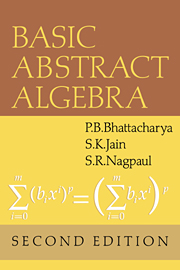Book contents
- Frontmatter
- Contents
- Preface to the second edition
- Preface to the first edition
- Glossary of symbols
- Part I Preliminaries
- Part II Groups
- Part III Rings and modules
- Chapter 9 Rings
- Chapter 10 Ideals and homomorphisms
- Chapter 11 Unique factorization domains and euclidean domains
- Chapter 12 Rings of fractions
- Chapter 13 Integers
- Chapter 14 Modules and vector spaces
- Part IV Field theory
- Part V Additional topics
- Solutions to odd-numbered problems
- Selected bibliography
- Index
Chapter 10 - Ideals and homomorphisms
Published online by Cambridge University Press: 05 June 2012
- Frontmatter
- Contents
- Preface to the second edition
- Preface to the first edition
- Glossary of symbols
- Part I Preliminaries
- Part II Groups
- Part III Rings and modules
- Chapter 9 Rings
- Chapter 10 Ideals and homomorphisms
- Chapter 11 Unique factorization domains and euclidean domains
- Chapter 12 Rings of fractions
- Chapter 13 Integers
- Chapter 14 Modules and vector spaces
- Part IV Field theory
- Part V Additional topics
- Solutions to odd-numbered problems
- Selected bibliography
- Index
Summary
The concept of an “ideal” in a ring is analogous to the concept of a “normal subgroup” in a group. Rings modulo an ideal are constructed in the same canonical fashion as groups modulo a normal subgroup. The role of an ideal in a “homomorphism between rings” is similar to the role of a normal subgroup in a “homomorphism between groups.” Theorems proved in this chapter on the direct sum of ideals in a ring and on homomorphisms between rings are parallel to the corresponding theorems for groups proved in Chapters 5 and 8.
Ideals
Definition.A nonempty subset S of a ring R is called an ideal of R if
(i) a,b ∈ S implies a - b ∈ S.
(ii) a ∈ S and r ∈ R imply ar ∈ S and ra ∈ S.
Definition.A nonempty subset S of a ring R is called a right (left) ideal if
(i) a,b ∈ S implies a - b ∈ S.
(ii) ar ∈ S (ra ∈ S) for all a ∈ S and r ∈ R.
Clearly, a right ideal or a left ideal is a subring of R, and every ideal is both right and left, so an ideal is sometimes called a two-sided ideal. Trivially, in a commutative ring every right ideal or left ideal is two-sided.
In every ring R, (0) and R are ideals, called trivial ideals.
Examples of ideals
(a) In the ring of integers Z every subring is an ideal. To see this, let I be a subring of Z and a ∈ I, r ∈ Z.
- Type
- Chapter
- Information
- Basic Abstract Algebra , pp. 179 - 211Publisher: Cambridge University PressPrint publication year: 1994



